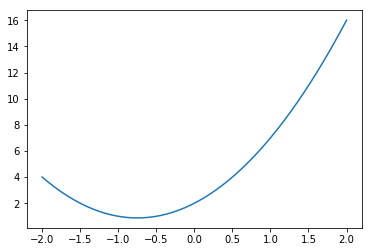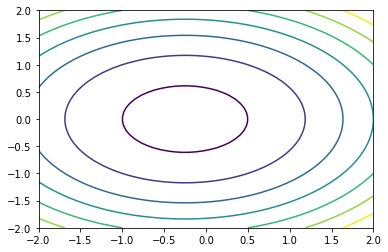Optimisation¶
The textbook often contains notation like
\[\min_x f(x)\]
How do we solve these problems in Python? We use
scipy.optimize.minimize.
In [1]:
from scipy.optimize import minimize
import numpy
Let’s try a one-dimensional example first: \(f(x) = 2x^2 + 3x + 2\)
In [2]:
def f(x):
return 2*x**2 + 3*x + 2
In [3]:
xx = numpy.linspace(-2, 2)
In [4]:
yy = f(xx)
In [5]:
import matplotlib.pyplot as plt
%matplotlib inline
In [6]:
plt.plot(xx, yy)
Out[6]:
[<matplotlib.lines.Line2D at 0x115491748>]

We see the minimum lies between -1 and -0.5, so let’s guess -0.5
In [7]:
result = minimize(f, -0.5)
result
Out[7]:
fun: 0.8749999999999998
hess_inv: array([[1]])
jac: array([ 2.98023224e-08])
message: 'Optimization terminated successfully.'
nfev: 9
nit: 1
njev: 3
status: 0
success: True
x: array([-0.75])
The return value is an object. The value of x at which the minimum was
found is in the x property. The function value is in the fun
property.
In [8]:
print("Minimum lies at x =", result.x)
print("minimum function value: f(x) = ", result.fun)
Minimum lies at x = [-0.75]
minimum function value: f(x) = 0.8749999999999998
In [9]:
minimize?
Let’s say we have constraints on \(x\):
\[\min_x f(x), -0.5 \leq x \leq 1\]
In [10]:
minimize(f, 0.5, bounds=[[-0.5, 1]])
Out[10]:
fun: array([ 1.])
hess_inv: <1x1 LbfgsInvHessProduct with dtype=float64>
jac: array([ 1.00000004])
message: b'CONVERGENCE: NORM_OF_PROJECTED_GRADIENT_<=_PGTOL'
nfev: 4
nit: 1
status: 0
success: True
x: array([-0.5])
Now let’s try a two-dimensional example:
\[\min_{x, y} 2x^2 + 3y^2 + x + 2\]
In [11]:
def f2(x):
return 2*x[0]**2 + 3*x[1]**2 + x[0] + 2
What does this look like? We can quickly generate values for the two
dimensions using meshgrid
In [12]:
x, y = numpy.meshgrid(numpy.arange(3), numpy.arange(0, 30, 10))
In [13]:
x + y
Out[13]:
array([[ 0, 1, 2],
[10, 11, 12],
[20, 21, 22]])
In [14]:
xx2d, yy2d = numpy.meshgrid(xx, xx)
In [15]:
plt.contour(xx2d, yy2d, f2([xx2d, yy2d]))
Out[15]:
<matplotlib.contour.QuadContourSet at 0x1155fd240>

In [16]:
minimize(f2, [1, 1])
Out[16]:
fun: 1.8750000000000004
hess_inv: array([[ 2.50000002e-01, -1.79099489e-09],
[ -1.79099489e-09, 1.66666665e-01]])
jac: array([ -1.49011612e-08, 0.00000000e+00])
message: 'Optimization terminated successfully.'
nfev: 24
nit: 4
njev: 6
status: 0
success: True
x: array([ -2.50000009e-01, -7.14132758e-09])
As expected, we find x=-0.25 and y=0
Now let’s constrain the problem:
In [17]:
minimize(f2, [1, 1], bounds=[[0.5, 1.5], [0.5, 1.5]])
Out[17]:
fun: 3.75
hess_inv: <2x2 LbfgsInvHessProduct with dtype=float64>
jac: array([ 3.00000003, 3.00000007])
message: b'CONVERGENCE: NORM_OF_PROJECTED_GRADIENT_<=_PGTOL'
nfev: 6
nit: 1
status: 0
success: True
x: array([ 0.5, 0.5])